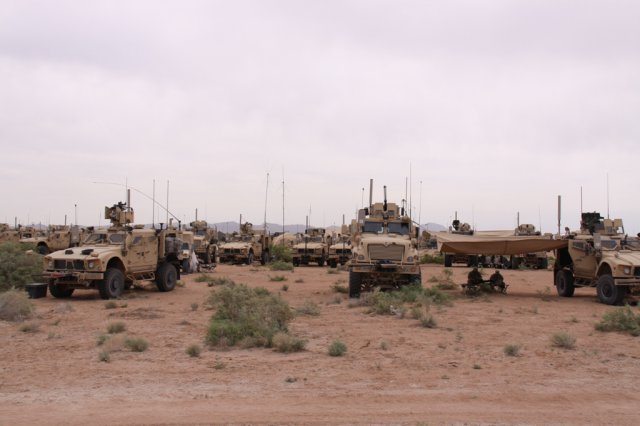The Army’s rapid fielding of network systems to support operations in Iraq and Afghanistan led to vastly improved communications capabilities on the battlefield — but also increased network complexity.
The service is now moving to simplify and reduce the number of network management tools its communication officers, known as S6s, use to manage the tactical communications network, moving from deliveries of stove-piped tool sets across various systems and echelons to an integrated system.
“The S6 has a wide range of network transport devices, applications and hardware that he has to manage and he has a lot of different program offices providing him with their own Network Operations (NetOps) tools that don’t necessarily work together,” said Lt. Col. Ward Roberts, product manager for Warfighter Information Network-Tactical, or PM WIN-T, Increment 3, who is leading the Army’s Integrated Tactical NetOps team. “But the goal of NetOps convergence is to provide one tool, or an easy to use integration of tools, into one seamless delivery so that the S6 has one tool set to manage his whole network.”
Led by the Program Executive Office for Command, Control, and Communications-Tactical, or PEO C3T, to which PM WIN-T is assigned, the Army is working to integrate and converge NetOps capabilities. The goal is to achieve network visibility from the enterprise level to the tactical level, while reducing the number of tools required. Integrating NetOps from the enterprise to the tactical edge will achieve efficiencies and improve operational flexibility. The NetOps efforts are just one component of the Army’s overall drive to simplify the network so it more resembles technology that Soldiers operate in their daily lives, making it easier and more efficient to use, train and sustain.
“Our young Soldiers are from a generation that has had iPhones, that has had Xboxes, that has grown up in an environment as digital natives,” said Brig. Gen. Daniel P. Hughes, program executive officer for PEO C3T. “They expect things to work a certain way. So we’ve got to get NetOps down to a minimal number of tools that are easy to use, so the Soldier can make the network operational on a very complex battlefield.”
The Army’s WIN-T network backbone provides Soldiers across the force with high-speed, high-capacity voice, data and video communications, and now with Increment 2 supports on-the-move network communications down to the company level. Today, WIN-T NetOps tool suites are supporting S6s in theater as they facilitate the planning, initialization, monitoring, management and response of the network.
WIN-T Increment 2- equipped brigades now have four times as many network nodes that units had in the past, as many radio and satellite assets once possessed by a division, making it a challenge to manage that network. But today’s improved WIN-T NetOps tools make it much easier to manage that complexity, said Chief Warrant Officer Eric Bache, brigade NetOps manager for 2nd Brigade, 1st Armored Division at the Army’s Network Integration Evaluation, or NIE, 14.1.
“With my NetOps tools I can take a look at the various nodes and say, ‘I don’t want that link, it’s not passing enough data,'” Bache said. “I can shut one off and reroute it through another radio or antenna.”
An improved WIN-T NetOps tool suite developed under the WIN-T Increment 3 program will serve as the baseline for tactical NetOps as the Integrated Tactical NetOps team works to converge other products, such as those used to manage the lower tactical internet, known as the TI.
“As the Army modernizes its network, it is pushing network systems lower and lower in the echelons, so computers are in places that they never were before, including physically on the Soldier,” said Rich Greel, technical management division chief for PM WIN-T. “With the increased size of the network, additional number of nodes, and the Army pushing it down lower in the echelons, we have to ensure that NetOps tools make it easy for the S6 to manage that network.”
Today, the lower TI — the radio-based network used at lower echelons on the battlefield — is compartmentalized and can be difficult for the Soldier to track and manage. One of the objectives of NetOps convergence is to integrate existing lower TI tools together and make them work seamlessly with WIN-T’s upper TI tools.
An early success for lower TI NetOps convergence was realized with the 2013 fielding of the Joint Tactical Networking Environment NetOps Toolkit, which collapsed several lower tactical network tools, mostly radio management tools, onto one laptop.
This spring the next version of the advanced WIN-T NetOps capabilities are scheduled to be evaluated at NIE 14.2, before they are eventually fielded to units equipped with WIN-T Increment 2. The Army’s semi-annual NIEs leverage Soldier feedback to improve capability and rapidly mature and integrate its tactical communications network. They have also been a venue to converge NetOps tools.
The first NIE event in 2011 included more than 70 separate systems to run and operate the network. That total is now closer to 20. Part of the NIE 14.2 WIN-T NetOps demonstration will include the use of Condition Based Maintenance Plus. This new preventative maintenance concept for the tactical communications network is similar to OnStar and other diagnostic software found in today’s cars, and aims to increase reliability and sustainability while reducing sustainment costs.
“We are using the NIEs to validate our steps along the way and not waiting until we have an end product that we want to ship out,” Roberts said. “We are making incremental improvements and getting those out to NIE to garner feedback from the Soldiers, the larger network community and from our industry partners to see if our tools are helping Soldiers out and what kind of improvements we may need to make.”
The biggest benefit in achieving a common NetOps solution would be incurred by the Soldier, specifically the S6. The goal is to give him one method to do his job, train him one time and with one set of tools, making his job a lot easier. The second benefit would be realized by the greater Army. Buying fewer tools or buying the same tools more strategically and cost effectively will save taxpayer dollars.
“We are figuring out ways to save money by buying things only once, only buying what we truly need, and buying in the best, most strategic approach possible to get better deals and save money,” Roberts said.
The Army does not plan to buy a “one-vendor, end-all NetOps solution,” but rather a combination of products from multiple commercial vendors, either seamlessly working together upfront or integrated through an Army effort, Roberts said.
“The more vendors that look to team with other vendors in the commercial-off-the-shelf industry to provide tools that work together, the better off we are, and the easier it will be to pick those products up and roll them into our baseline,” Roberts said.











